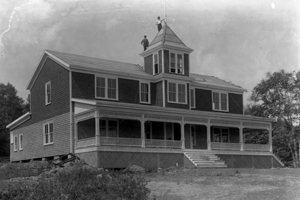European settlement
Kejimkujik National Park and National Historic Site
The Settlers’ Legacy

Photo: P. Yates
European settlement of the area began around the 1820s, and while a few farms were cleared, logging and gold mining also played an important role in the history of Kejimkujik. In the early 1900s, the area became a destination for sportsmen seeking hunting and fishing adventures.
Farming
Though nearly half of the land in Kejimkujik was originally granted to farmers, very little cultivation was undertaken except for a few farms in the eastern part of the Park. These were all located on hills where the soils are best.
Logging

Photo: P. Hope
It is uncertain when logging began in the Keji area but almost all of the land has been cut over at some time. In the early days, most of the logs cut were driven down through the lakes and rivers, some as far as Liverpool. The remains of numerous sawmills testify to local operations in more recent times.
Gold Mining
Three small gold mines existed within the Keji area. Although the workings in these mines yielded little ore to their owners, they did yield a variety of “tall tales” and they brought new attention to the area. The remains of pits, iron boilers, and cabins can still be found. You can visit one mine on the Gold Mines Trail, which features interpretive signs.
The Resort Era

Photo: P. Yates
Early settlers’ accounts of the Kejimkujik area describe a desolate wilderness, where the thin soils, rocks, and bogs would support nothing useful. It was this wilderness that became a haven for those who sought fishing, hunting, or simply to get away. To provide accommodation for the sportsmen, lodges and cabins were built around Kejimkujik Lake. The best known, and most luxurious, was Kedge Lodge. Many local men were hired as guides for these visitors, and the history of guiding is a colourful chapter in the area’s history.
- Date modified :